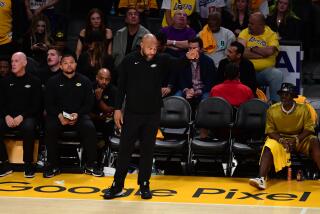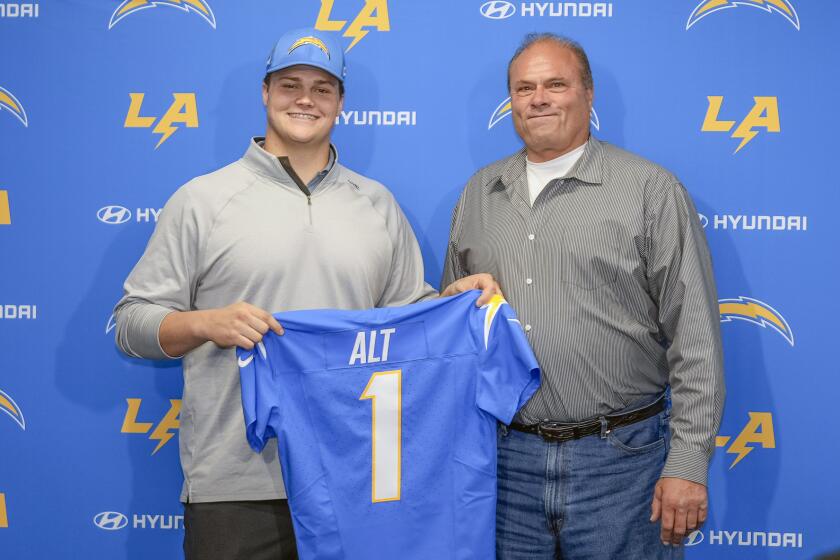Where there’s smoke, there’s tire
IT’S a truism of racing: A squealing tire is a happy tire.
In which case, Vaughn Gittin Jr.’s tires are positively giddy as the 25-year-old part-time IT manager and full-time throttle monkey slides his 700-horsepower Mustang around one of Irwindale Speedway’s low banked turns. And not just a minor slide, either, no NASCAR “she’s a little loose in the corner” slide, but a huge, obscene, major-malfunction, beg-for-mercy power slide that makes his four Falken tires smoke like a Haitian roadblock.
Behind the car a layer of fog worthy of the old DDT mosquito trucks hangs over the asphalt. We are well and truly sideways at 90 mph. I am in the passenger seat, hanging onto a piece of roll cage -- which is to say, in the parlance of racing, I’ve got ahold of the Jesus handle.
In any other motor sport, such a slide would end rather noisily against a wall, after which there would commence an impromptu sale of used car parts. But this is the Japanese motor sport of drifting, in which racers are judged on the speed, accuracy, daring and balletic grace of their driving as they slide sideways -- drift -- around a serpentine course.
An expert in controlled chaos, Gittin spins the wheel in the other direction and pumps the clutch. The car’s rear end pitches around violently and now, instead of looking out the right side window, I’m looking out the left, and the car, fully crossed up and filling with tire smoke, arcs around an orange traffic cone -- a corner “apex.”
This is just a practice session for Gittin and team Falken, a warm-up for this weekend’s D1 Grand Prix drifting event at Irwindale. But, Gittin says, “I like to go big all the time.”
Uh-huh. Can I get out now?
Drifting gets ‘Fast and Furious’
Never heard of drifting? Well, that’s about to change. Coming in June to a mondo-plex near you is “The Fast and the Furious: Tokyo Drift,” the third installment of the car-porn franchise that first brought us the thespian exploits of Vin Diesel in 2001. This time, the story involves a young American hot rodder who gets in trouble with the law, flees to Japan and -- behind the wheel of his father’s ’69 Mustang fastback with a turbocharged Nissan motor in the snout -- eventually confronts the evil, yakuza-connected “Drift King” in a cliff-hanging race up a mountain road, the climactic “race of death.”
I kid you not.
The car is a metaphor for the main character, Shaun -- an American with a Japanese heart. “It’s very similar to ‘Karate Kid II,’ ” says Dennis McCarthy, the film’s stunt car coordinator, who helped destroy 80 cars in the process. “It’s the same story, except instead of karate, it’s cars.”
If the film signals drifting’s breach into the American mainstream, in Japan it has been an organized sport for about a decade and an underground subculture for decades before that. Indeed, to hear enthusiasts tell it, drifting’s origins are shrouded in mystery worthy of Zatoichi the Blind Swordsman.
It apparently evolved out of illegal road racing on winding mountain roads (or touge) in the 1960s -- nobody knows where or when, exactly. Renegade racers -- known as rolling zoku -- adapted rally-racing cornering techniques, pitching their cars around a corner with the tail swinging wide in order to maintain max speed. Think of a hand-brake-pulling Batmobile-turn around a hairpin corner.
Eventually, these racers migrated to urban areas, bringing their screaming-sideways driving to the city streets. There, it drew the attention of Japan’s emergent anti-authority youth culture and the ire of, well, the authorities. In time, enthusiasts organized trials at tracks and in parking lots. During the ‘90s, drifting fed into the same adrenaline stream that produced the Japanese domestic market sport-compact car craze.
In a trajectory similar to hot rodding’s morphing into sanctioned drag racing in the United States in the 1950s, drifting went legit. In 2001, magazine publisher Daijiro Inada and pro driver Keiichi Tsuchiya founded the D1 Grand Prix series, which you might think of as the Formula 1 of going sideways.
And then it jumped the pond.
Southern California was already heavily invested in noisy Japanese imports, as any number of frantic suburbanites could have told you. The area is ground zero for the sport-compact/tuner car market. So when the first big-time drifting competition in the U.S., a D1GP exhibition event, took place at Irwindale Speedway on Aug. 31, 2003, it found an eager audience.
The 10,000-strong crowd “was the largest number of people ever at the track,” says Doug Stokes, who was the speedway’s public relations manager at the time. “The place was packed to the gunnels.”
In 2006, the D1GP series will make two stops in the United States (all the others are in Japan): the first this weekend and the second in December, either returning to Irwindale or traveling to California Speedway in Fontana.
But Hideo Tomitaka, vice president and director of U.S. operations of D1GP, prefers Irwindale. “It is uniquely suited for drifting events,” he says. “It’s a place where we can put on the event close to spectators.... They can hear it, feel it, smell it” -- and, of course, have a ringside seat for the mayhem.
“The cars are always on the edge of control,” he says. “Cars run into each other and concrete walls. That is an expected part of the fun for the spectators.”
Judge for yourself
Drifting events are usually two-day affairs. On Friday, during first-round qualifying -- free and open to the public at Irwindale -- drivers will make solo runs around the course.
“In qualifying it’s all about big speed, big angle and big smoke,” says Rhys Millen, an accomplished stunt driver (he was the lead car jockey on “The Dukes of Hazzard” and “The Fast and the Furious: Tokyo Drift”) who also won the 2005 season championship in the U.S.-based Formula Drift series.
Like figure skating, judging evaluates compulsory elements with the extra element of style. And, like figure skating, the judging can be mysterious. “Sometimes you’ll finish a run and you know you’ve won,” Millen says. “And then the other guy goes through and you just look over at the judges and say, ‘Come on, is this on the level?’ ”
On Saturday, the top 32 drivers compete in an elimination round, again taking solo passes around the course to be judged by a three-person panel on speed, angle of attack and other nuances. The top 16 drivers will then pair up for what are called “twin battles,” a sort of automotive dogfight in which two cars try to stay as close to each other as possible while performing their lurid, smoke-billowing maneuvers.
“The dynamic really comes into play when you put two cars side by side,” says Millen, whose dad, Rod Millen, is a famous road racer who will also compete this weekend. “It’s a situation that’s not been seen before in other motor sports. To watch the kind of control drivers have, it’s definitely a big wow factor for the fans.”
After four rounds of paired eliminations, it all comes down to two cars chasing each other wheel to wheel in -- a race of death! Nah, not really. For the record, there have never been any fatalities in a D1GP event. But there is always plenty of high-speed, car-dismantling action.
“Race highlights on TV are usually two minutes long, and a minute-30 of that is crashes,” Gittin says. “Fans want to see carnage. In drifting you don’t know if the cars are going to come together or the guy is going to back into the wall at 130 mph.”
In December 2005, Gittin -- a native of Annapolis, Md. -- became the first American driver to win a D1GP event, albeit an exhibition.
“Everybody said it would take Americans three to five years to beat the Japanese drivers,” Gittin says.
Getting ready for this weekend’s event, Gittin says, “I feel like I have a bull’s-eye on my back, because they’d never been beaten by an American driver, especially in an American car.”
Gittin and Millen both drive American-brand cars -- a Ford Mustang and a Pontiac GTO, respectively. (Never mind that the GTO is built in Australia. It’s the thought that counts.) That puts them in a distinct minority among drifters, who generally prefer Japanese coupes, cars like the Nissan 240SX and 350Z and the Mazda RX-7. But that mix is changing on the track, not least because American carmakers are supporting drifting programs. No one wants to sit out the next youth-oriented motor sport craze.
According to the Specialty Equipment Market Assn. in Diamond Bar, the trade organization that represents the automotive aftermarket, drifting-related sales are worth about $750 million annually.
“Gen Y is a huge market,” Gittin says. “Carmakers both endemic and nonendemic [Japanese and American] see that drifting has a very big grasp of that market.”
And of course, the tire makers are in bliss, because drifting is a sport that seems specifically designed to evaporate truckloads of tires. (And, by the way, has anyone checked with the Environmental Protection Agency?) For the D1GP event, Gittin’s sponsor Falken will bring 14 tires for his car: 10 for the back and four for the front.
Coming to America
Though born in Japan, drifting is finding a happy home in America. Formula Drift -- the American companion series to D1GP, founded in 2003 -- will hold eight events nationwide this year, with the first next month during the Long Beach Grand Prix. Californians can attend drifting events -- lapping days, driver searches and clinics -- on average every couple of weeks. Amateurs with a hankering to go sideways can check websites for organizing groups such as Club4AG, Drift Buffet, Formula D and D1GP. (And, as they say: Kids, don’t try this outside the Dairy Queen.)
One reason for drifting’s quick uptake in the States is that the sport connects to bigger themes in American car culture -- if you can call getting buck wild and boiling tires off the rims a “bigger theme.”
“Actually, we’ve been seeing this all along,” says Jim Spoonhower of the Specialty Equipment Market Assn. “This goes back to the ‘50s and ‘60s with guys doing doughnuts on parking lots. It’s just a different form, a different way to express that enthusiasm.”
You would also have to credit the worldliness of the World Wide Web. As early as the mid-’90s, Gen-Y gear heads were able to follow Japanese car culture from an ocean away. Soon they were hanging out on drifting websites, ordering instructional DVDs and buying esoteric Japanese car magazines from hole-in-the-wall newsstands.
As a result, many drifters’ experience was like Gittin’s.
“In 2000 I heard about something called drifting,” he says. “I did some research online and thought, ‘Wow, I’ve been doing this all along!’ I didn’t know there was a sport where I could burn tires, go sideways and have fun.”
Drifting is also a sign of Japan’s growing status as global cultural exporter.
“The Pokemon generation is in college now,” says Mizuko Ito, a researcher at USC’s Annenberg School for Communication and an expert in Japan studies. “And so now they are moving on to more sophisticated fare, and that’s where you get drifting and the kind of edgy anime you can see on ‘Adult Swim,’ ” the off-kilter late-night programming on Cartoon Network.
Yet cultural appropriation always leaves its local mark. Just as French hip-hop is uniquely French and Indian food in London has a curiously British inflection, drifting is becoming an American sport with a Japanese heart -- not unlike Shaun, the “Fast and the Furious” hero.
Drifting is just another way of turning. Japanese.
*
(BEGIN TEXT OF INFOBOX)
Drifting events
D1 Professional Drift Grand Prix Series
Where: Irwindale Speedway, 500 Speedway Drive, Irwindale
When: Qualifying noon to 6 p.m. Friday; gates open at 9 a.m. Saturday, practice session at 10 a.m., opening ceremony at 2:30 p.m., final competition at 6:45 p.m.
Price: Friday, free; Saturday, $25 in advance, $30 at the door
Info: www.d1gp.com
Formula Drift Championship Series
Where: Long Beach Grand Prix course in downtown Long Beach
When: 10 a.m. to 4 p.m. April 2
Price: $20
Info: www.formuladrift.com
Also
What: Drifting events during Long Beach Grand Prix weekend
When: 5 to 5:25 p.m. April 7, 3:10 to 3:30 p.m. April 8, 3:20 to 3:40 p.m. April 9
Price: $55 for three-day general admission to all Long Beach Grand Prix events
Info: www.longbeachgp.com
More events on the Web
www.driftday.com, www.driftcircuit.org, www.justdrift.com, www.driftbuffet.com
More to Read
Get our high school sports newsletter
Prep Rally is devoted to the SoCal high school sports experience, bringing you scores, stories and a behind-the-scenes look at what makes prep sports so popular.
You may occasionally receive promotional content from the Los Angeles Times.






